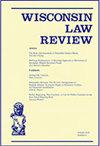规范通俗语言
IF 0.7
4区 社会学
Q2 LAW
引用次数: 0
摘要
一位学者在消费者合同领域所创造的“无声革命”已经酝酿了半个世纪。这场革命远远超出了消费者合同的范畴。立法机构和监管机构通过了700多部通俗易懂的法律,将通俗易懂的语言融入到消费者合同、通知、披露、政府报告、法庭表格、选举选票等方面。他们这样做的目的只有一个:让法律文件更容易理解。这一共同目标跨越了理论,突破了传统的私法-公法之分。然而,尽管有共同的目标,议员们在如何实现这一目标上存在巨大分歧。其结果是宪法、法规和规章的奇怪拼凑,差异巨大。通过研究这些变化,本文探讨了以前被忽视的平实语言法律设计的规范性含义。立法者必须决定涵盖哪些文件,适用什么标准,允许什么样的执法和处罚,这必然涉及经典的政策决策,比如在自由市场和监管之间做出选择,分配负担和成本,以及划定界限。因此,本文认为,认为文档设计是一种律师技能的传统观点是错误的,这种观点可以简化为方便的“最佳实践”列表。立法者已经取代了律师的自由裁量权。他们的参与,以及他们设计选择的规模和复杂性,已经将简单的语言转化为由典型的公共政策驱动的法律原则。此外,明文法律的复杂性超出了如何设计法律的范畴,还涉及到谁来设计法律这一更基本的问题。立法机构和监管机构编纂的复杂法律,与法院单方面注入的广泛的普通法明文要求并存。可以预见的是,如此多的决策是由不同的决策者做出的,差异在全国范围内普遍存在。这种差异造成了三权分立、紧张和效率低下,因为起草者很难找到并遵守不同立法者提出的许多不同要求。本文主张扩大通俗语言普通法,因为法院最适合制定这样的标准。事实证明,简单的语言法则一点也不简单。本文章由计算机程序翻译,如有差异,请以英文原文为准。
Regulating Plain Language
What one scholar coined a “quiet revolution” in consumer contracts has been a half century in the making. And the revolution extends well beyond consumer contracts. Legislatures and regulators passed over seven hundred plain language laws infusing plain language into consumer contracts, notices, disclosures, government reports, court forms, election ballots, and more. They did so with one goal in mind: make legal documents more understandable. This shared goal crosses doctrines and pierces the traditional private law-public law divide. Yet, despite sharing a goal, lawmakers differ dramatically on how to achieve it. The result is a bizarre patchwork of constitutions, statutes, and regulations with massive variations. By examining these variations, this Article takes on the previously overlooked normative implications of plain language law design. Lawmakers must decide which documents to cover, what standard to apply, and what enforcement and penalties to allow, which necessarily involves classic policyinfused decisions like choosing between the free market or regulation, allocating burdens and costs, and line drawing. As a result, this Article contends that the traditional view that document design is a lawyer skillset reducible to convenient lists of “best practices” is wrong. Lawmakers have replaced lawyer discretion. Their involvement, and the scale and complexity of their design choices, have converted plain language into a legal doctrine driven by quintessential public policies. More, the complexity of plain language laws extends beyond how to design the laws to the more fundamental question of who designs them. The complex patchwork of codified laws from legislatures and regulators sits alongside expansive common law plain language requirements unilaterally injected by courts. Predictably, with so many decisions made by different decisionmakers, discrepancies pervade the national landscape. Such discrepancies create separations of powers tension and inefficiencies as drafters struggle to find and comply with the many different requirements from different lawmakers. This Article argues for an expansion of plain language common law, because courts are best equipped to create such a standard. It turns out plain language laws are anything but plain.
求助全文
通过发布文献求助,成功后即可免费获取论文全文。
去求助
来源期刊

Wisconsin Law Review
Social Sciences-Law
CiteScore
1.00
自引率
16.70%
发文量
0
期刊介绍:
The Wisconsin Law Review is a student-run journal of legal analysis and commentary that is used by professors, judges, practitioners, and others researching contemporary legal topics. The Wisconsin Law Review, which is published six times each year, includes professional and student articles, with content spanning local, state, national, and international topics. In addition to publishing the print journal, the Wisconsin Law Review publishes the Wisconsin Law Review Forward and sponsors an annual symposium at which leading scholars debate a significant issue in contemporary law.
 求助内容:
求助内容: 应助结果提醒方式:
应助结果提醒方式:


